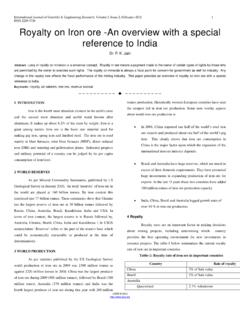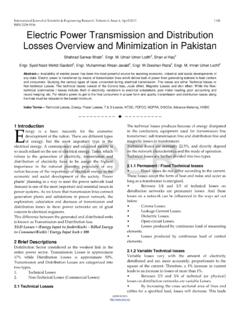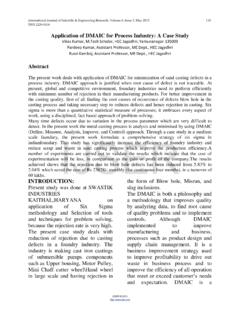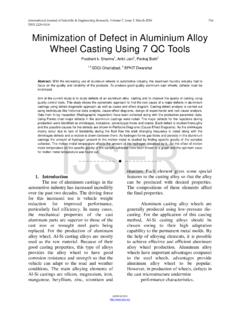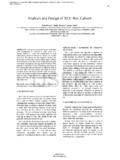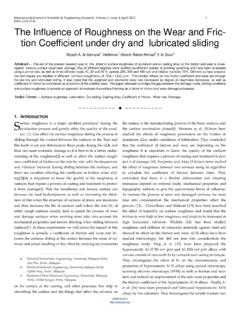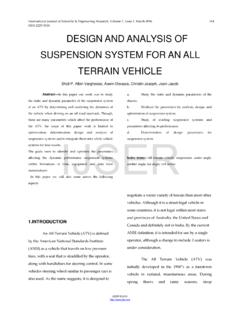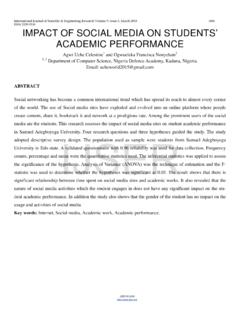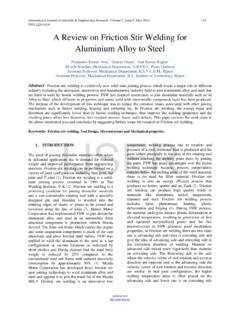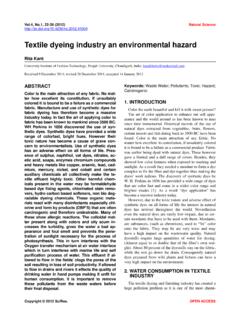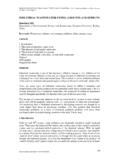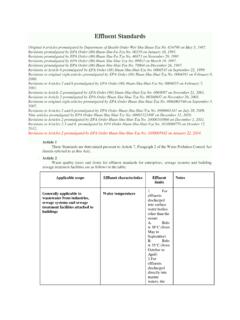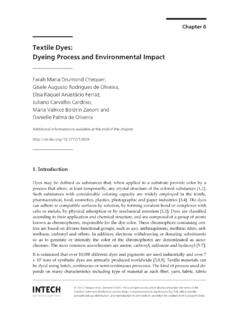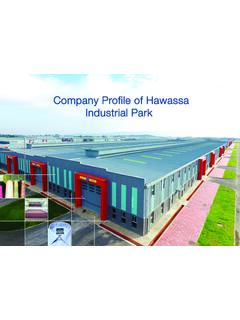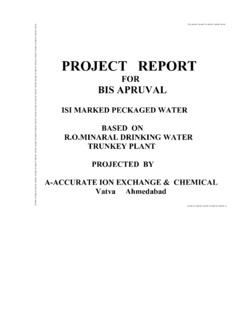Transcription of A Review of the Textile Industries Waste Water Treatment ...
1 International Journal of Scientific & Engineering Research, Volume 7, Issue 1, January-2016 392 ISSN 2229-5518 IJSER 2016 A Review OF THE Textile Industries Waste Water Treatment METHODOLOGIES Deepa Chandran Abstract : textiles is one of the largest Industries in the world. The Textile industry generates huge quantities of complex chemical substances as a part of unused materials including dyes in the form of wastewater during various stages of Textile manufacturing and processing. The Textile industry effluents which are discharged are treated with various physical and chemical treatments such as coagulation, flocculation, ozonation and biological Treatment for the removal of nitrogen, phosphorous, organics and metal traces. This paper reviews the various Treatment methodologies for Textile wastewater with the advantages and disadvantages of the same.
2 Introduction textiles being the largest Industries in the world, is one of the Industries to cater to the basic needs of humans, and has been rapidly growing, more so in the developing countries. Different types of fibres that constitute the Textile industry are cellulosic either from natural sources or regenerated, protein fibres that are mostly animal derivatives and the manmade fibres that are synthesized. Each of these fibres require different class of dyes to color them. The cellulosic fibres like cotton, viscose etc. have affinity to direct dyes, indigo dyes, reactive and naphthol dyes. Protein fibres are good to dye with acid dyes. Manmade fibres have affinity to disperse dyes. Basic and direct dyes are also used here. In the process of producing textiles and in the application of color on them, the Textile industry gets chemically intensive and hence the major polluter of Water .
3 The Textile industry generates huge quantities of complex chemical substances as a part of unused materials including dyes in the form of wastewater during various stages of Textile manufacturing and processing. To produce 1kg of Textile about 200L of Water is consumed [1]. The chemicals present in the Waste Water cause harm to both human health and the environment. They block the sunlight passage through the Water , hamper photosynthesis, increase the biological oxygen demand and affect the aquatic life. The direct discharge of this Waste Water into the environment affect its ecological status by causing various undesirable changes. This has a high importance in terms of its environmental bearing, since it consumes considerably high quantity of Water and produces highly polluted wastewater in large amounts. The Textile Industries are required to control their discharges and have effluent Treatment plants for environment protection.
4 To protect the environment from the harmful effect of the Waste generated, the ministry of Environment, Government of India has set standards for the wastewater and other wastes which are discharged into the environment after Treatment . To ensure that the wastes meet the norms set by the Government, all the Textile mills adopt various processes and technologies available in this regard. It is increasingly important in today s advanced way of life, to conserve the natural resources and the environment for the needs of the present and the future generations and economy. IJSERI nternational Journal of Scientific & Engineering Research, Volume 7, Issue 1, January-2016 393 ISSN 2229-5518 IJSER 2016 The Waste Water is the primary and the most polluting component of the Textile industry s effluent .
5 The conventional techniques adopted to treat the wastewater are physical, chemical and biological methods. 1. Physical Sedimentation (Clarification), screening, aeration, Filtration, Flotation and skimming, degasification, Equalization. 2. Chemical Chlorination, Ozonation, Neutralization, Coagulation, Adsorption, Ion exchange 3. Biological a. Aerobic Activated sludge Treatment methods, Trickling filtration, oxidation, ponds, lagoons, aerobic digestion b. Anaerobic Anaerobic digestion, septic tanks, Lagoons The Treatment process can be sequenced as below: I. Primary Treatment Removal of suspended solids, oil, grit etc. II. Secondary Treatment Use of microorganisms in either aerobic or anaerobic condition for the reduction of the BOD, removal of color , oil and phenol. III. Tertiary Treatment Use of electro dialysis, ion exchange and reverse osmosis for the final removal and purification of the wastewater The Textile industry effluents which are discharged are treated with various physical and chemical treatments such as coagulation, flocculation, ozonation and biological Treatment for the removal of nitrogen, phosphorous, organics and metal traces.
6 The disadvantages of the physic chemical processes are the formation of sludge, disposal of sludge and the space needed. The disadvantages of the biological processes are the presence of the toxic heavy metals which hamper the growth of microorganisms, most of the dye stuff used are non-biodegradable in nature and the time requirement for the Treatment is more [1]. PRIMARY Treatment PROCESS The first step is the removal of suspended solids, excessive quantities of oil, grease and gritty materials. The effluent is first screened for coarse suspended materials such as yarns, lint, pieces of fabrics and rags using bar screens and fine screens [2]. The screened effluents then undergo settling for the removal of the suspended particles. The floating particles are removed by mechanical scraping systems. Ultrafiltration using modified poly vinylidene fluoride membrane which has 60% of styrene-acrylonitrile in content and 40% poly vinylidene fluoride with a porous top layer and a sub-layer with a number of pores.
7 The color removal and COD reduction is moderate accompanied by reduced membrane fouling for separation and purification of dye solutions [3]. IJSERI nternational Journal of Scientific & Engineering Research, Volume 7, Issue 1, January-2016 394 ISSN 2229-5518 IJSER 2016 The Treatment by ultrafiltration and /or nano filtration nullify some of the limitations of the membrane process such as fouling, pore blocking and cake formation and enables Water reuse [4]. The nano filtration techniques achieve a sharp reduction in COD along with the dyes removal from the permeate [5]. The cross flow nano filtration with the help of a thin film composite polysulfone membrane working at low pressures, relatively high fluxes are obtained, with an average dye rejection of 98% and NaCI rejections of less than 14%. Thus, a high quality of reusable Water is recovered [6].
8 The electro flotation technology is effective in removing colloidal particles, oil & grease, as well as organic pollutants with better performance than either dissolved air flotation, sedimentation, impeller flotation [7]. Electro deposition is effective in recovery of heavy metals from wastewater streams [7]. To reduce the acidic contents of the effluents neutralization is done. Sulphuric acid and boiler flue gas are the most commonly used chemicals to alter the pH. A pH value of 5-9 is considered ideal for the Treatment process [8] (Babu R et al., 2007). The screening is followed by sedimentation which makes use of gravity to settle the particles. Simple sedimentation is not effective and is also space consuming process. Coagulation should be carried out which is advantageous, with ferrous sulphate, lime, alum, ferric sulphate or ferric chloride [9]. A combination of fluidized biofilm with chemical coagulation and electrochemical oxidation effectively decreases the pollutant loading on the post Treatment process [10].
9 Electrocoagulation with aluminum, iron or the hybrid Al/Fe electrodes are suitable for Water production or wastewater Treatment [7]. Utilization of plant-based coagulants are comparable to their chemical counterparts in terms of efficiency. This represents important progress in sustainable environmental technology as they are renewable resources and their application is directly related to the improvement of quality of life in the ecosystem [11]. The use of Ipomoea dasysperma seed gums is effective for decolourization of direct dye and in combination with conventional coagulants like polyaluminum chloride their coagulation efficiency is well extended even for reactive and acid dyes [12]. Some novel pre-hydrolyzed coagulants such as a polyaluminum chloride, polyaluminum ferric chloride, polyferrous sulphate and polyferrous sulphate and polyferric chloride have been found to be more effective for decolourisation of the Waste Water .
10 Use of natural coagulants for Treatment has also been emphasized and encouraged as the viable alternative because of their eco-friendly nature. Synthetic metallic salts as well as synthetic and natural polymers from different origins have also been used for the removal of Textile colors. [13]. For the specific removal of vat dye and reactive black, the application if a food grade polysaccharide namely Plantago psyllium mucilage shows that the flocculation efficiency is sensitive to pH when pure aqueous solutions of dyes are used, but it is relatively unaffected by pH change when salts are added to the dye solutions. The results show that the mucilage is more effective for removal of solubilized vat dye than for reactive black [14]. Some of the disadvantage with flocculation system are that they are in a risk of getting short-circuited and the floc formation in the system is difficult to control.
